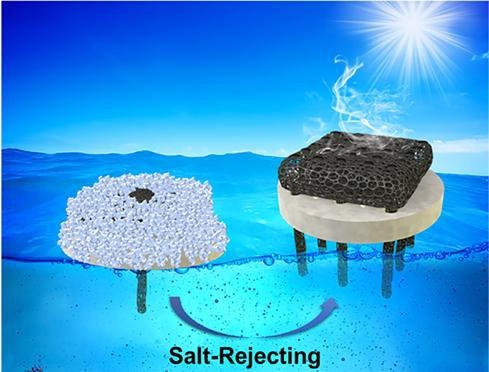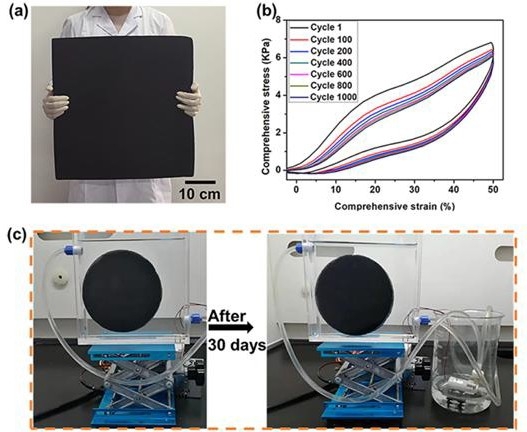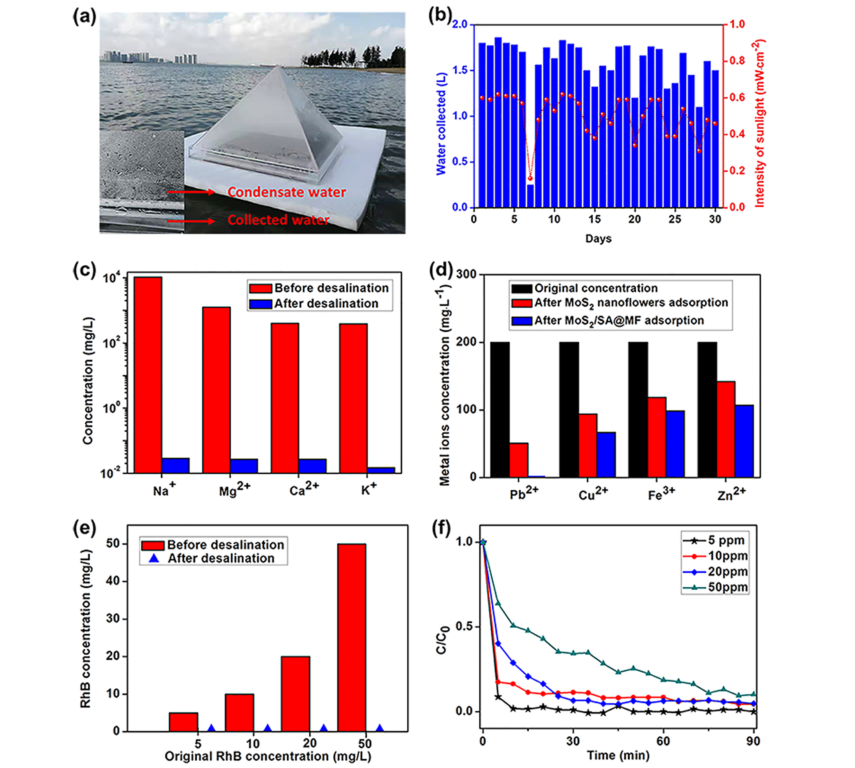近几十年来,清洁水的短缺已成为最严峻的全球挑战之一。太阳能蒸汽转化(STG)被认为是缓解淡水短缺的一种很有前途的策略。通过该技术,可以进行海水淡化或废水净化, 将太阳能转化为热能、电能、机械能等的同时收集清洁的水,碳足迹最小。近年来,人们对STG 系统的性能进行了广泛的研究。尽管该策略尽管在提高效率方面取得了很大进展,但STG 中盐沉积已成为制约蒸发器高效、连续水生产的一个至关重要的问题。
In recent decades, the scarcity of clean water has become one of most severe global challenges. Solar steam generation (STG) has been regarded as a promising strategy to relieve concerns on freshwater shortage. By means of this technology, we can collect clean water through seawater desalination or wastewater purification by converting solar radiation to heat, electrical power, mechanical energy, etc., with a minimal carbon footprint. In recent years, extensive research works have been carried out to improve the performance of STG system. Though great progresses have been made to improve the efficiency, salt deposition in the STG evaporator presents vital issues to an effective and continuous water production.
在本工作中,一种通过简单、可扩展、低成本地浸渍-干燥-交联过程的MoS2/SA 三聚氰胺泡沫蒸发器被研发制备。研究显示,在一个太阳光照下和 3.5 wt% NaCl 溶液中,面积为4 × 4 cm 的 MoS2/SA@MF 蒸发器的蒸发率可达到 1.92 kg/m2.h,并能实现高达 90%的光热转换效率。本工作除了巧妙利用三聚氰胺泡沫骨架的双重多孔结构之外,还通过精心设计的人工钻孔和水通道切割等策略充分加速水的输送和盐离子对流。经过系统地研究表明,MoS2/SA@MF 复合海绵具有良好的力学稳定性和粘附性能,具有广阔的应用前景。此外, 即使在盐度高达 20wt%的盐水中,连续光照 100 小时后,MoS2/SA@MF 蒸发器上也无盐的沉积,且蒸发率仍能保持 1.81kg/m2.h,光热转换效率高达 84.8%,优于大多数报道的工作。
A MoS2-sodium alginate hydrogel wrapped melamine foam (MoS2/SA@MF) hybrid sponge is developed through simple, scalable and low-cost dipping–drying–crosslinking process. In this work, a 4 × 4 cm MoS2/SA@MF evaporator shows an evaporation rate of 1.92 kg/m2.h in 3.5 wt% NaCl solution under 1 kW.m−2, achieving a solar-thermal conversion efficiency of 90%. Additional to bimodal porous structure of the MF skeleton, thanks to meticulous designs, including drilling through-holes and cutting water-channels on the STG evaporator, the water transportation and salt ions convection are fully accelerated. It is systematically illustrated that a significant improvement in salt rejecting performance is achieved with a 1.81 kg/m2.h evaporation rate even after 100 h in a brine salinity up to 20 wt% under 1 kW.m−2. In addition, a consistent and effective solar-thermal conversion efficiency of 84.8% is also achieved superior to most reported works.
本研究以天然海绵的独特特性为灵感,通过简单、灵活、绿色、低成本的浸渍-干燥-交联工艺,开发了一种MoS2-海藻酸钠水凝胶包覆三聚氰胺泡沫(缩写为MoS2/SA@MF)混合海绵作为太阳能蒸汽发生器(STG)蒸发器(方案1)。
Inspired by the unique features of natural sponges, in this work, we develop a MoS
2
-sodium alginate hydrogel wrapped melamine foam (abbreviated as MoS
2
/SA@MF) hybrid sponge as a solar steam generation (STG) evaporator through simple, flexible, green, and low-cost dipping–drying–crosslinking process (Scheme 1).

方案1. 用于太阳能蒸汽发电的海洋灵感MoS2/SA@MF混合海绵的设计概念示意图,以及提高其抗盐性能的策略。
Scheme 1. Schematic illustration of the design concept of a marine-inspired MoS2/SA@MF hybrid sponge for solar steam generation and the strategy to improve its
salt-rejecting performance.
制备MoS2/SA@MF杂化海绵的浸渍-干燥-交联工艺示意图如图1a所示。原始MF、MoS2/SA-Ca@MF海绵和MoS2/SA@MF海绵的SEM图像分别如图1b-d所示。
与原始MF相比,经过浸渍-干燥-交联工艺生成了一层厚度为数百纳米的MoS2/SA水凝胶。结果表明,MoS2/SA水凝胶层均匀地包裹在MF骨架上,这是MF具有良好亲水性的原因。由于其简单、易操作、绿色环保和低成本的特点,该制备工艺在大规模加工方面也显示出很大的前景。如图2a所示,通过这种简单的策略,我们可以在实验室中轻松制备出50 cm × 50 cm × 2 cm的MoS2/SA-Ca@MF海绵。
The schematic diagram of the dipping–drying–crosslinking process for the preparation of the MoS2/SA@MF hybrid sponge is shown in Fig. 1a. The SEM images of pristine MF, the hybrid MoS2/SA-Ca@MF sponge and MoS2/SA@MF sponge are shown in Fig. 1b–d, respectively. Compared with the pristine MF, a layer of MoS2/SA hydrogel with a thickness of hundreds of nanometers was generated after the dipping–drying–crosslinking process. It is clearly shown that the MoS2/SA hydrogel layer is uniformly wrapped on the MF skeleton attributing to the good hydrophilicity of MF. The preparation process also shows great promise for large-scale processing due to its simplicity, easy operation, green, and low-cost features. As shown in Fig. 2a, we can easily prepare a 50 cm × 50 cm × 2 cm MoS2/SA-Ca@MF sponge in the lab by this simple strategy.

图1. MoS2/SA@MF杂化海绵的制备及形貌。(a)制备MoS2/SA@MF混合海绵的浸渍-干燥-交联工艺示意图。扫描电镜图像。(b)市售的原始三聚氰胺泡沫。(c)凝胶交联前的杂化海绵。(d)钙凝胶化和化学交联后的杂化海绵。
Fig. 1. Preparation and morphologies of the MoS2/SA@MF hybrid sponge. (a) Schematic illustration of the dipping–drying–crosslinking process for the preparation of the MoS2/SA@MF hybrid sponge. SEM images. (b) The commercially available pristine melamine foam. (c) The hybrid sponge before gelation and crosslinking. (d) The hybrid sponge after calcium gelation and chemical crosslinking.
MoS2/ SA@MF杂化海绵在50%应变条件下第1 ~ 1000个试验循环的压缩应力-应变曲线如图2b所示。混合海绵表现出优异的柔韧性,在第1000次试验循环后未观察到明显的塑性变形(≈5%)。MoS2/SA水凝胶与MF的良好附着力也通过30天的冲洗测试平台得到了证明(图2c)。MoS2/SA@MF复合海绵具有良好的力学稳定性和粘附能力,具有广阔的应用前景。
Compressive stress–strain curves of the MoS2/ SA@MF hybrid sponge for the 1st to 1000th test cycles at 50% strain are shown in Fig. 2b. An excellent flexibility is revealed within the hybrid sponge and no significant plastic deformation (≈5%) is observed after 1000th test cycles. The excellent adhesion of MoS2/SA hydrogel with MF is also demonstrated by using a flush-through test platform for 30 days (Fig. 2c). The robust mechanical stability and excellent adhesion ability suggest that the MoS2/SA@MF hybrid sponge is potential in practical applications.

图 2 (a) 50×50×2cm MoS2/SA@MF 海绵照片。(b)MoS2/SA@MF 海绵在 50%应变下第 1-1000 次循环的压缩应力-应变曲线。(c) MoS2/SA@MF 海绵的冲刷试验。
Fig. 2. (a) Photo of a 50 × 50 × 2 cm MoS2/SA@MF hybrid sponge. (b) Compressive stress–stain curve of MoS2/SA@MF hybrid sponge for the 1st to 1000th test cycles at 50% strain. (c) The flush-through tests of MoS2/SA@MF hybrid sponge.
光吸收是研制高效STG蒸发器的前提。从UV - vis - NIR吸收光谱可以明显看出,MoS2/SA@MF混合海绵在整个太阳光谱上表现出广泛而高效的吸收性能,由于MoS2的纳米花结构和MF的孔隙通道,其阳光吸收率达到92.3%(图3a)。图3b是开放表面系统中太阳蒸汽测试装置的示意图,以及在1 kW.m−2条件下20分钟后4 × 4 × 1 cm MoS2/SA@MF蒸发器的红外图像。从红外图像上可以清楚地证明吸收体上的热是受限的。吸收体表面温度可达45.9℃,比原水高20℃。为了进一步探索能有效提高太阳能热转换效率的海洋型混合海绵的设置,在1 kW.m−2的3.5% NaCl溶液中,评估了开放式表面体系和不同尺寸的MoS2/SA@MF蒸发器的减重分布(图3c)。每个剖面的点是在相同的实验条件下进行的五次测量的平均值。相应的蒸发速率列在剖面上面。面积为4 × 4cm和2 × 2cm的蒸发器的确定蒸发速率分别为1.92 kg/m2.h和2.80 kg/m2.h,分别比露天系统(0.14 kg/m2.h)高13倍和20倍以上。研究表明,随着蒸发器尺寸的增大,上层水输送能力的减小可能导致蒸发器的蒸发速率降低。因此,将4 × 4 cm蒸发器的供水管道由原来的1个改为8个。然而,其蒸发速率的增加可以忽略不计。因此,系统几何形状的减小导致蒸发换热系数减小,导致蒸汽扩散速率降低。分别测量了在Copt = 1 kW.m−2条件下,MF、MoS2 @MF、MoS2/SA@MF等不同组成的STG蒸发器质量随时间的变化(图3d)。此外,还测量了不同光强(0.7、2、4太阳)下的蒸发速率,并计算了相应的太阳热转换效率(图3e)。插图是在两次太阳照射下所产生的蒸汽的数码照片。研究发现,得益于MoS2/ SA@MF STG蒸发器良好的太阳能吸收、水管理和加热管理,在0.7、1、2和4个太阳照射下,蒸发速率分别达到1.12、1.92、3.11和6.41 kg/m2.h。太阳能热转换效率分别从75%、90%、93.1%提高到94.3%(在0.7、1、2和4个太阳下),表明集中太阳照射下,由于局部加热更多,水分蒸发更快,能源利用效率提高。与已报道的海绵基材料(图3f)相比,我们的工作不仅避免了复杂和高成本的制备过程,而且实现了更高的蒸发速率和更有效的太阳能热转换效率。
The light absorption is a prerequisite for developing highly efficient STG evaporator. From the UV−vis−NIR absorption spectra, it is obvious that the MoS2/SA@MF hybrid sponge shows broad and efficient absorption performance across the entire solar spectrum and achieves 92.3% sunlight absorption, thanks to the nanoflower structure of MoS2 and the pore channels of the MF (Fig. 3a). Fig. 3b is the schematic illustration of the solar steam test setup in an open surface system and the infrared images of a 4 × 4 × 1 cm MoS2/SA@MF evaporator after 20 min under 1 kW.m−2. From the infrared image, it is clearly proved that heat is confined on the absorber. The absorber surface can reach to 45.9 ℃, which is 20 ℃ higher than that of the bulk water. To further explore the setup of the marine-inspired hybrid sponge that can effectively improve the solar-thermal conversion efficiency, the weight loss profiles of open surface system and the MoS2/SA@MF evaporator with different sizes have been evaluated in 3.5% NaCl solution under 1 kW.m−2 (Fig. 3c). The point of each profile is an average of five measurements done with the same experimental conditions. The corresponding evaporation rates are listed above the profiles. The determined evaporation rate for the evaporator with a 4 × 4 cm and 2 × 2 cm area is 1.92 kg/m2.h and 2.80 kg/m2.h, respectively, which is over thirteen and twenty times higher than that of the open surface
system (0.14 kg/m2.h) separately. It is reported that the decreased capacity of water transportation to the top layer might result in a lower evaporation rate of the evaporator that with an increasing size. Therefore, 8 water channels were cut, instead of one water channel to improve the water supply in the 4 × 4 cm evaporator. However, there is a negligible increase in its evaporation rate. Hence, it is suggested that the reduce of the system geometry causes a decrease in the evaporation heat transfer coefficient and results in a lower vapor diffusion rate. The mass changes of the STG evaporators with different compositions, including MF, MoS2 @MF and MoS2/SA@MF as a function of time under Copt = 1 kW.m−2 were also measured respectively (Fig. 3d). Furthermore, the measurements of evaporation rates under different optical intensity (0.7, 2, 4 sun) have been conducted and the corresponding solar-thermal conversion efficiencies have been also calculated (Fig. 3e). The inset is digital photograph of the steam generated under 2 sun irradiations. It is found that, benefiting from good solar absorption, water management and heating management of the MoS2/ SA@MF STG evaporator, the evaporation rate can be accelerated reaching to 1.12, 1.92, 3.11 and 6.41 kg/m2.h under 0.7, 1, 2 and 4 sun, respectively. In addition, the corresponding solar-thermal conversion efficiency can be enhanced from 75%, 90%, 93.1% to 94.3% (under 0.7, 1, 2 and 4 sun), indicating that an enhanced energy utilization efficiency because of more localized heating and faster water evaporation under a concentrated solar irradiation. Comparing with reported sponge-based materials (Fig. 3f), our work not only avoid complicated and high cost preparation process, but also achieve a higher evaporation rate and more effective solar-thermal conversion efficiency.

图3所示。(a)纯MF、SA@MF、MoS2纳米花和MoS2/SA@MF杂化海绵的紫外-可见-近红外吸收光谱。(b)在开放表面系统中太阳蒸汽测试装置的示意图和在1 kW.m−2下20分钟后4 × 4 × 1 cm MoS2/SA@MF蒸发器的红外图像。(c)不同尺寸MoS2/SA@MF蒸发器的减重情况。(d) 1 kW.m−2以下不同组成的STG蒸发器。(e)不同光强下蒸发速率和光热转换效率的性能比较。插图是由两次太阳照射产生的蒸汽的数码照片。(f)本研究的蒸发速率和太阳能热转换效率与以前文献的性能比较。
Fig. 3. (a) UV−vis−NIR absorption spectra of pure MF, SA@MF, MoS2 nanoflowers and MoS2/SA@MF hybrid sponge. (b) Schematic illustration of the solar steam test setup in an open surface system and the infrared image of a 4 × 4 × 1 cm MoS2/SA@MF evaporator after 20 min under 1 kW.m−2. (c) The weight loss profile of MoS2/SA@MF evaporator with different sizes. (d) STG evaporator with different compositions under 1 kW.m−2. (e) Performance comparison in evaporation rates and solar-thermal conversion efficiencies under different optical intensity. The inset is digital photograph of the steam generated from 2 sun irradiation. (f) Performance comparison in evaporation rates and solar-thermal conversion efficiencies of this work with previous references.
为了研究其防盐性能,在1个太阳下测量了上述MoS2/SA@MF STG蒸发器在不同盐水盐度下的蒸发速率。STG蒸发器在盐水盐度为3.5、7、15、20和25 wt% NaCl溶液中,蒸发速率分别为1.92、1.90、1.88、1.81和1.78 kg/m2.h。相应的太阳能热转换效率也略有下降,分别为90%、89.5%、88.1%、84.8%和83.4%(图4a)。结果与众所周知的规律一致,即盐水盐度较高的溶液表面张力较纯水大,蒸发速率略有降低。从盐水盐度为20 wt% NaCl溶液中水分蒸发速率的性能对比(图4b)可以看出,S1的蒸发速率下降最快,在100小时后从1.81 kg/m2.h下降到0.96 kg/m2.h下降了47.0%。钻通孔对S2的防污能力在前72 h略有提高,但蒸发速率在100 h后从1.79 kg/m2.h下降到1.50 kg/m2.h。证明了钻通孔的额外水通道除了由MF骨架相互连通的孔道组成的双峰多孔结构外,还可以加速S3和S3*中水和盐离子的运输和对流。其机理如图4c所示。由于溶液输送和盐离子回流更快,S3和S3*有明显的改善,其中在100 h后的脱盐率下降微不足道(1.81 kg/m2.h),并且达到了稳定有效的84.8%的太阳能热转换效率,优于大多数报道的脱盐蒸发器(图4d)。
To study the salt-rejecting performance, the evaporation rate of the above MoS2/SA@MF STG evaporator has been measured in various brine salinity under 1 sun. When the STG evaporator is in a brine salinity of 3.5, 7, 15, 20 and 25 wt% NaCl solution, the evaporation rate is 1.92, 1.90, 1.88, 1.81 and 1.78 kg/m2.h, respectively. A slightly decrease is also observed in the corresponding solar-thermal conversion efficiency, which is 90%, 89.5%, 88.1%, 84.8% and 83.4%, respectively (Fig. 4a). The results are consistent with the well-known law, i.e., a solution with a higher brine salinity leads to a larger surface tension comparing with that of pure water, and thus causes the evaporation rate a slightly decrease. From the performance comparison of water evaporation rate in a brine salinity of 20 wt% NaCl solution (Fig. 4b), it shows that the one of S1 decreases most quickly with a drop of 47.0% from 1.81 kg/m2.h to 0.96 kg/m2.h after 100 h. The antifouling ability of S2 with drilling through-holes is slightly improved to a certain extent in the former 72 h, though the evaporation rate drops from 1.79 kg/m2.h to 1.50 kg/m2.h after 100 h. It is proved that, additional to bimodal porous structure composed by interconnected pore channels of MF skeleton, the extra water-channels of drilling through-holes can accelerate the transportation and convection of water and salt ions in S3 and S3*. The mechanism is schematically illustrated in Fig. 4c. Owing to the quicker solution transportation and salt ions backflow, there is a significant improvement in S3 and S3*, in which the salt rejecting with a negligible decrease in evaporation rate (1.81 kg/m2.h) after 100 h. Also, a stable and effective solar-thermal conversion efficiency of 84.8% is achieved superior to most reported salt-rejecting evaporator (Fig. 4d).

图4所示。STG蒸发器的防盐性能。(a) 1个太阳下不同盐度下的蒸发速率和太阳热转换效率。(b)各种精心设计的STG蒸发器在盐度为20 wt% NaCl溶液中的蒸发速率。(c)基本机制示意图。(d)本研究在蒸发速率和太阳能热转换效率方面的拒盐性能与以往文献的比较。
Fig. 4. The salt-rejecting performance of the STG evaporator. (a) The evaporation rate and solar-thermal conversion efficiency in various brine salinity under 1 sun. (b) The evaporation rate of STG evaporator with various meticulous designs in a brine salinity of 20 wt% NaCl solution. (c) Schematic illustration of the underlying mechanism. (d) Salt-rejecting performance comparison in evaporation rates and solar-thermal conversion efficiencies of this work with previous references.
从蒸发器随时间变化的数字照片可以更直接地观察到其防污能力(图5)。对于S1,在48h后,一层盐壳逐渐从边缘向内部沉淀 。因为边缘部分离水道最远。在蒸发过程中,边缘区域首先达到过饱和,从而导致结晶。最终形成一层连续的盐结晶层,除中心有一小块圆形区域外,几乎完全覆盖整个蒸发器,固体盐难以聚集(图5a)。由于S2上的钻通孔,盐从边缘向中心逐粒结晶,更容易收集(图5b),而不是连续的盐层。与S1相比,由于盐沉淀不连续,100 h后蒸发速率仅下降16.2%。如上所述,对于S3和S3*,由于多水通道的存在,加速了水的输送和离子对流过程,因此在100 h后,样品的上表面仍处于不饱和盐溶液中,没有结晶。需要注意的是,72 h后,PS泡沫边缘和S3侧面的盐结晶开始蠕变,这与S2的现象类似。S3*与水隔离,不太可能在100 h后没有盐结晶蠕变到PS泡沫上,S3*侧面也没有盐沉淀。
The antifouling ability can be much more directly observed from the digital photographs of the evaporators over time (Fig. 5). For S1, a layer of salt crust gradually precipitated from the edge to the inner after 48 h. Because the edge part is farthest from the water channel. During the evaporation process, the edge region foremost reaches to supersaturation and consequently leads to crystallize. Eventually, a continuous layer of salt crystallization is formed and almost fully covered the whole evaporator except a small circular region in the center, which is hard for solid salt collecting (Fig. 5a). Instead of a continuous salt layer, the salt crystallized grain by grain from the edge part to the center region and is easier for collecting attributing to the drilling through-holes on S2 (Fig. 5b). Also, comparing to that of S1, the evaporation rate drop is only 16.2% after 100 h because of the discontinuous salt precipitation. As mentioned above, for S3 and S3*, the water transportation and ions convection processes are accelerated by the multi-water-channels, and thus the top surface of the samples remains in unsaturation salt solution without crystallization even after 100 h. It should be noted that salt crystallization starts to creep on the edge of PS foam and the side of S3 after 72 h, similarly to the phenomena in S2. Unlikely, for S3*, which is isolated from water, no salt crystallization creeps onto the PS foam, neither salt precipitates on the side of S3* after 100 h.

图5所示。a)-d) S1、S2、S3和S3*防污能力的数字照片。
Fig. 5. Digital photographs of the antifouling ability of a)-d) S1, S2, S3 and S3*.
MoS2/SA@MF蒸发器不仅具有良好的蒸汽生成和除盐性能,而且由于其操作简便、规模大、制造成本低、机械稳定性好等优点,有可能应用于恶劣海洋环境下的水净化。图6a是简单太阳能蒸馏原型,蒸发器尺寸为50厘米× 50厘米, 材料成本在每平方米1元左右。在壁上可以清晰地观察到凝结水,并且可以通过金字塔式太阳能蒸馏器的凹槽收集(图6a插图)。为评估装置的耐久性,从2019.10.01 - 2019.10.30连续记录收集水的重量30天。结果表明,除阴天外,平均每天收集冷凝水约1.75 L,基本满足一个成年人的饮用水需求(图6b)。
The MoS2/SA@MF evaporator can not only present an excellent performance in steam generation and salt rejection, but also be potentially applied in water purification in a harsh realistic ocean situation because of its easy, scale, cheap fabrication cost and excellent mechanical stability. Fig. 6a illustrates a simple solar distillation prototype, the size of the evaporator is 50 cm × 50 cm and the cost of the materials is around RMB 1 per every square meter. The condensed water is vividly observed on the wall and able to be collected by the groove of the pyramid solar stiller (Fig. 6a inset). To evaluate the durability of the device, the weight of collected water is continuously recorded for 30 days from 2019.10.01 to 2019.10.30. The results show that the average collected condense water per day is about 1.75 L except for the cloudy days, which basically satisfies the drinking water requirement for an adult (Fig. 6b).
此外,发现四种主要离子(Na+、Mg2+、Ca2+和K+)的浓度降低到远低于世界卫生组织(WHO)要求的安全水平(图6c)。此外,还表明MoS2/SA@MF STG蒸发器在废水处理方面具有很大的潜力。重金属离子去除性能如图6d所示。每个重金属离子的初始浓度为200mg.L−1。仅用悬浮在污染海水中的MoS2纳米花吸附4h后,Pb2+、Cu2+、Fe3+和Zn2+的浓度分别降至50.8、93.9、118.6和142 mg.L−1。相比之下,MoS2/SA@MF蒸发器吸附后,Pb2+、Cu2+、Fe3+和Zn2+的浓度急剧下降至0.08、66.9、98.4和107 mg.L−1,表明MoS2/SA@MF混合海绵对重金属离子的去除更有效。尤其对Pb2+离子,效率可达99.96%。同时,MoS2/SA@MF蒸发器也表现出良好的有机染料去除性能,尽管有机染料在加热的水中会挥发。从直方图(图6e)可以看出,RhB初始浓度分别为5、10、20和50 ppm的污染海水的凝结水中没有检测到RhB。此外,从记录的吸附动力学曲线(图7f)来看,当RhB的初始浓度小于20 ppm时,30 min内>的效率达到90%。当初始浓度达到50 ppm时,90 min后也可达到> 90%的效率。
In addition, it is found that the concentrations of four main ions (Na+, Mg2+, Ca2+, and K+) are reduced much lower than the safety levels required by World Health Organization (WHO) (Fig. 6c). Moreover, it also shows that the MoS2/SA@MF STG evaporator has great potential in wastewater treatment. Fig. 6d shows the heavy metal ion removal performance. The initial concentration for each heavy metal ion is 200 mg.L−1 in the contaminated seawater. After adsorption with only MoS2 nanoflowers suspending in the contaminated seawater for 4 h, the concentration of Pb2+, Cu2+, Fe3+ and Zn2+ is reduced to 50.8, 93.9, 118.6 and 142 mg.L−1, respectively. By contrast, after adsorption with the MoS2/SA@MF evaporator, the concentrations of Pb2+, Cu2+, Fe3+ and Zn2+ is sharply reduced to 0.08, 66.9, 98.4, and 107 mg.L−1, respectively, demonstrating that the MoS2/SA@MF hybrid sponge is more effective in heavy metal ion removal. Particularly for Pb2+ ions, the efficiency is up to 99.96%. Meanwhile, the MoS2/SA@MF evaporator also represents an excellent organic dye removal performance though the organic dye can volatilize at the heated water. From the histograms (Fig. 6e), it is demonstrated that no RhB is detected in the condensed water with contaminated seawater with 5, 10, 20 and 50 ppm initial concentration of RhB, respectively. Additionally, from the recorded adsorption kinetic curves (Fig. 6f), it shows that an efficiency of > 90% is achieved within 30 min when the initial concentration of RhB less than 20 ppm. When the initial
concentration up to 50 ppm, an efficiency of > 90% can also be achieved after 90 min.

图6所示。(a)漂浮着的太阳能金字塔照片。插图是侧墙的冷凝水和太阳能蒸馏器槽中收集的水的照片。(b)连续记录太阳强度,收集30天的水。(c)太阳能脱盐前后4种主要离子(Na+、Mg2+、Ca2+和K+)的浓度。(d)重金属离子(Pb2+、Cu2+、Fe3+和Zn2+)的去除性能。(e)有机染料、RhB去除性能;(f)原溶液中RhB归一化吸附量与浓度的关系。
Fig. 6. (a) Photograph of a pyramid solar still floating.The inset is the photograph of condensate water in the side wall and collected water in the troughs of the solar still. (b) The continuously recorded solar intensity and collected water for 30 days. (c) The concentrations of four kind of primary ions (Na+, Mg2+, Ca2+, and K+) before and after solar desalination. (d) Heavy metal ion (Pb2+, Cu2+, Fe3+ and Zn2+) removal performance. (e) Organic dye, RhB removal performance and (f) Normalized RhB adsorption amount versus concentration of RhB in original solution.
综上所述,受天然海绵独特特性的启发,我们构建了一个MoS2/SA@MF混合海绵蒸发器,用于高效和连续的水蒸发和海水淡化。相应的紫外-可见-近红外吸收光谱表明,MoS2/ SA@MF杂化海绵在200~2000 nm波长范围内具有广泛而高效的吸收性能,吸收效率为92.3%。MoS2/SA@MF蒸发器具有良好的太阳能吸附、水管理和加热管理性能,在0.7、1、2和4个太阳照射下,在3.5 wt% NaCl溶液中蒸发速率可达1.12、1.92、3.11和6.41 kg/m2.h,有效太阳能热转换效率分别为75%、90%、93.1%和94.3%。此外,得益于自上而下的设计,蒸发器在20 wt%的模拟海水中连续蒸发100 h后仍能保持在不饱和盐溶液中无结晶,蒸发速率稳定在1.81 kg/m2.h,稳定有效的太阳能热转换效率为84.8%。此外,该装置具有良好的耐用性,除阴天外,平均每天可连续产生1.75 L的水,基本满足一个成年人的饮用水需求。最后,研究还表明,MoS2/SA@MF蒸发器是一种很有前途的应用于含重金属离子和有机小分子染料的水处理的候选装置。对污水中Pb2+离子的去除率可达99.96%。当RhB初始浓度小于20 ppm时,30 min内>效率达到90%。本研究为海绵基STG蒸发器在海水淡化和污水处理中的实际应用提供了参考。
In summary, inspired by the unique features of natural sponges, we have constructed a MoS2/SA@MF hybrid sponge evaporator for highefficient and continuous water evaporation and desalination. The corresponding UV−vis−NIR absorption spectra illustrate that the MoS2/ SA@MF hybrid sponge presents a broad and efficient absorption performance with a efficiency of 92.3% over a wavelength of 200~ 2000 nm. Benefits of the excellent solar adsorption, water management and heating management of the MoS2/SA@MF evaporator, the evaporation rate can reach up to 1.12, 1.92, 3.11 and 6.41 kg/m2.h in 3.5 wt% NaCl solution under 0.7, 1, 2 and 4 sun consisted with an effective solar-thermal conversion efficiency of 75%, 90% 93.1% to 94.3% respectively. Moreover, benefiting from the top-down design, the evaporator can remain in unsaturation salt solution without crystallization after a continuous evaporation for 100 h in 20 wt% simulated seawater, and the evaporation rate is able to stabilize at 1.81 kg/m2.h with a stable and effective solar-thermal conversion efficiency of 84.8%. Furthermore, it reveals that its device has an excellent durability of continuously generating an average of 1.75 L water per day except for the cloudy days, which basically satisfies the drinking water requirement for an adult. Finally, the study also illustrates that the MoS2/SA@MF evaporator is a promising candidate to be applied in water treatment containing heavy metal ions and organic small molecular dyes. The efficiency is up to 99.96% for removing Pb2+ ions from contaminated water. An efficiency of > 90% is achieved within 30 min when the initial concentration of RhB less than 20 ppm. This study presents a hint of sponge-based STG evaporator in practical application in seawater desalination and wastewater treatment.
 公众号
公众号